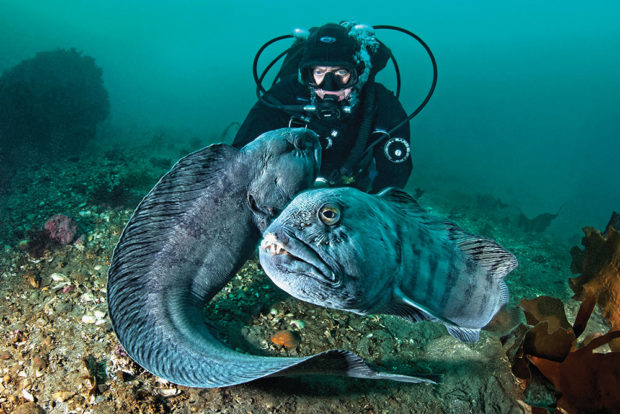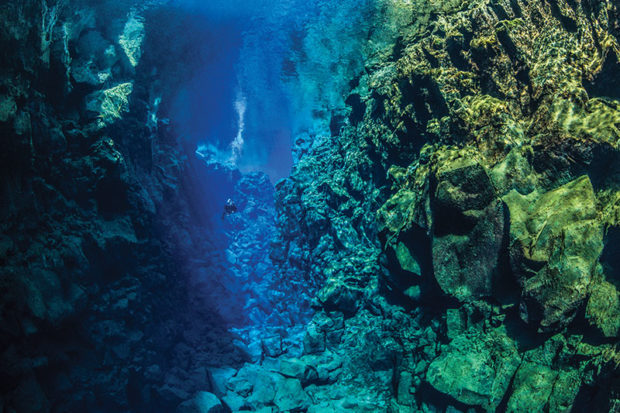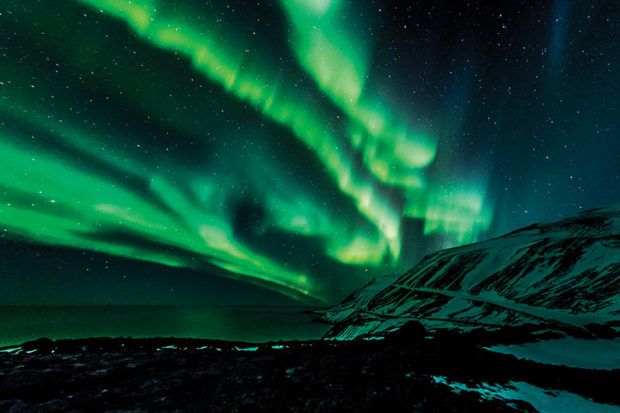Iceland: At the top of the world

Tobias Friedrich explores a place where the laws of nature don’t apply, where mountains appear in monochrome and where continents move and lakes are alive…
My journey begins in Reykjavík, the capital of the least populous country in Europe. It is cold, although the sun is shining. Even in the summer months, the thermometer rarely breaks the 70 degree mark Fahrenheit (21°C), and in winter it is light only four hours a day. Nevertheless, it is crowded in the square in front of the Hallgrímskirkja, the famous church. From the church tower you have a perfect view of the whole city. Looking down from 240 feet (73m), the bright colours of the rooftops are even brighter, especially when the sun shines on them. Reykjavík is modern, styish, and architecturally striking. Everything is fascinatingly different – nature, as well as architecture. Also underwater.
Silfra
I choose to start my underwater exploration of Iceland with DIVE.IS in Reykjavík, a popular diving centre founded by German ex-pat Tobias Klose. One of their most popular and (not without reason) frequently booked-out tours is the trip to the Thingvellir National Park, in the west of the Icelandic highlands. There, due to the uniqueness of the geology and landscape, is one of the most unique dive sites in the world: Silfra (translation = the silver woman), a mile-long (1.6km) gap between huge rock faces, created 135 million years ago due to continental drift. The North American and Eurasian continental plates are drifting apart; the gap widens every year by almost a quarter inch (7mm). At present, the gap is still so narrow that you don’t even have to spread your arms completely to be able to touch the majestic rocks on both sides. Where else in the world is it possibile to dive between the continental plates?
This singularity of the region attracts swarms of dive tourists from all over the world, and, I must admit, the mystique of the experience is a somewhat lessened by the masses. Nevertheless, the experience is unique and compelling. From the surface, the water shimmers brown and opaque, but once you are under the surface, you are surprised by the incredible visibility. It’s so clear that you can see almost 300 feet (90m). Although the gap can be dived in about half an hour, do not underestimate the icy water temperature. Because meltwater from the Langjökull glacier flows through the surrounding rock and feeds Silfra, the water does not get warmer than 39°F (4°C), even in summer. Thick neoprene gloves, dry suit, a good undershirt, and at least two pairs of woolen socks are definitely recommended so you can really enjoy the experience.

Not for nothing is Thingvellir National Park/Silfra a UNESCO World Heritage Site. A total of four sections can be dived, which despite their proximity are extremely different. Beginning at the Big Crack, you pass through huge rock formations, which project irregularly into the water column on both sides. There are few fish, but when the sun shines, the rocks shimmer golden under the water. Next you dive through the Silfra Hall. Here the sunshine is strongest and the colours change depending on the time of day and the strength of the sun. The dense algae bed on the rocks glows in a lush green. As the blue of the water contrasts with the black of the rocky shadows as you dive through the formations, you understand why Silfra is one of the best freshwater dive sites in the world. After the Silfra Hall you dive through shadowy Silfra Cathedral. The many shadows come from snorkelers, who also come to experience the breathtaking views. The end of the Silfra diving experience is the shallow Silfra lagoon. Thanks to its shallow depth of about 16 feet (5m) and the wide view you get from the clear water, the lagoon appears a calidescope of colours: the bottom manifests in orange, surrounded by pale yellow sand and green algae, the water is light turquoise, the surface dark blue. Silfra is truly distinct and makes a great subject for photography.
As you drive from Reykjavík to the southwest, you move away from civilization. Glacial lakes and snowfields alternate with lava deserts and fjords. White snow and rich green meadows characterize the landscape. The air is clear and fresh, and from time to time you see a sheep. Not far from the capital, only about 15 miles (25km) southwest, is another inconspicuous and much less touristy highlight: Kleifarvatn. The roads here are not always tarred and without four-wheel drive you can’t get far when it’s wet. Kleifarvatn is a geothermal lake in the midst of an active volcanic landscape, surrounded by ochre mountain ranges, some of them snow-covered and shimmering turquoise. When the sky is cloudy, it looks as if the mists of fog are touching the water. The sight is breathtaking. Time seems to stand still. The place is quiet and deserted…and the lake steams.

Kleifarvatn
After the earthquake in 2000, the natural lake threatened to seep away. Today it has almost regained its original water level. Kleifarvatn harbours few fish, yet the lake is alive. Once you submerge, you see it’s bubbling everywhere and you feel like you’re swimming in a huge hot tub full of little soap bubbles or big raindrops. If you follow the bubbles, at about 20 to 45 feet (6-14m) you will encounter a crater. The crater bubbles and steams, and smells of sulfur. Countless numbers of these craters in a wide variety of shapes and sizes line the bottom at close intervals. Your lips tingle slightly from the bubbling water and even with a thick drysuit you can feel the heat that comes out of each crater. The lake averages 46°F (8°C), which is relatively warm for Iceland, but at the hot springs it gets to 64°F (18°C), and sometimes even warmer. Unfortunately, the visibility is spotty and everything takes on a greenish-yellow tinge. The geothermal activities of the volcanic lake form sulfur deposits that settle on the sandy ground, making the water undrinkable for humans. And not so good for fish, it would seem – not infrequently a dead trout or two rolls by on a gentle wave over the volcanic bottom of the lake. Diving in the Kleifarvatn volcanic lake is the stuff of fantasy: a geothermally active lake, surrounded by sulfur mountains; it feels like it could be an underwater scene from Lord of the Rings.
Jökulsárlón
Driving from Reykjavík on Highway 1, the ring road, further south, about 230 miles (370km) from the capital, adjacent to the Vatnajökull National Park, is the Glacier Lagoon Jökulsárlón. On cloudy days, when the sun is barely visible, it feels like you’re looking through a black and white filter. The volcanic sand is deep black, the huge glaciers glimmer white, and you have to squint your eyes, the snow is so bright. The sight is surreal and the glacier lake a real natural wonder. Again and again huge chunks of glacier break off and float like shapeless boats in the deepest lake of the island. When the ice crystals reflect the water, the whole lagoon shimmers blue. Taking a boat across the lake, you can experience this spectacle up close. Many film directors have used this unreal scenery as a film set (Batman Begins and James Bond – Die Another Day are just two examples). A visit to the glacier lagoon is definitely a must during your stay in Iceland.
While driving along the outlying roads of Iceland, you will rarely encounter animals. Due to the Arctic climate, biodiversity on the island southeast of Greenland is poorer than anywhere else in Europe. In addition to what feels like an infinite number of sheep, polar foxes, some bird species and the Icelandic horses make their home here. If the Arctic cold paralyzes biodiversity above water, it reinforces it under water. Because Gulf Stream and East Greenland stream meet here, there are over 300 different species of fish and large numbers of whales. It is not surprising that every tenth Icelander makes a living as a fisherman.
Strýtan
Further to the north of the island, about 250 miles (400km) from Reykjavík, is the town of Akureyri, the pearl of the north, with just under 20,000 inhabitants. This is where the Strýtan Divecenter is located. Erlendur Bogason has been the owner for many years, and now his daughter works with him. Erlendur is a fur seal, a true warhorse, an adventurer. No water is too cold, no risk too big. As a professional diver, teacher, discoverer, explorer, and scientist, he is a surpringly modest man who has dived kilometre-long drainpipes in total darkness to find damaged sections. On the first floor of the old warehouse that is the dive centre, he exhibits a collection of things he has brought up from dives and wants to share. Broken pieces of a shipwreck lie on the table, unopened eggs, shells, woods, plants. “Before the dive, I tell divers what they will see and experience,” he says, pointing to the myriad of maps and exhibits. “I want to give them an awareness of the environment. We have to protect it.”
It’s often snowing here, and the wooden dock is covered with a soft white layer of snow when the experienced diver takes the small boat out to sea. He has been doing this almost every day for 25 years. In 1997, 21 years ago, he and his friend Arni Halldorsson made an incredible discovery in the fjord Eyjafjörður, not far from the city Akureyeri. While they knew that the area around the fjord must be home to geothermal activity, they were overjoyed to discover ‘Strýtan’, a deep-sea chimney. ‘White smokers’, which normally only occur in depths greater than a mile (1.75km), were now also in the reach of scuba divers.
The water that flows out of the smokers is 167°F (75°C) degrees hot, and the origin of the cones goes back to the Ice Age. They are products of minerals that have been released for 11,000 years and contain magnesium silicates that solidify when they hit the cold water. So the cylinders grow continuously upwards. Altogether there are three cones; the tip of the largest smoker is at 50 feet (15m) and reaches to 215 feet (65m). The visibility isn’t great and the streams of hot water, which shoot breathtakingly fast from the cones, worsen the vis. Nevertheless, you get to see a lot. One highlight is Stephanie. At least, this is what Erlendur calls what is probably the most trusted sea-wolf in the world. Although the animals are naturally shy, Stephanie is keen on Erlendur. As soon as he is underwater, she comes straight to him. He can scratch her on the belly and back of the head and she eats mussels that Erlendur has previously cracked for her. Erlendur is also called “Wolffish Whisperer” and has been researching the behaviour of animals for many years. Occasionally, and with a bit of luck, whales also can be seen in the fjord.
“Wait a minute”, says Erlendur, before we go diving and dips his thermos bottle into the hot spring water. Immediately after we surface there is hot chocolate. A chocolate spring, so to speak.

Nesgjá
Erlendur is familiar with another secret of Iceland: Nesgjá – the unknown. The continental gap, which offers Silfra divers an unforgettable diving experience, runs all over Iceland and also opens to the north-east, about two hours’ drive from Akureyri. Through countless reconnaissance trips and dives, Erlendur has located this fisure, which is far removed from the tourist areas of Iceland and still a secret little tip. The approach to the fisure can be a bit difficult; you have to leave the car at the side of the road and walk to the fisure. The 500 foot (150m)-long gap, which isn’t really much more than a ditch, is located next to a small lake and is as crystal clear as Silfra. At least until the first divers have hit the water. Because the algae on the rocks in the 20 foot (6m)-deep fisure dissolve at the smallest disturbance, even the slightest glancing blow with your fins will result in a greenish snowstorm. Fortunately, there are almost no other divers to be found here. If you’re planning to take photographs, do so first, while the visibility is still perfect and clear. At the end of Nesgjá turn right into the small lake, where you can dive back to an exit if you do not want to climb over the rocks of the fisure. For divers who want to dive away from the masses and in some of the clearest waters in the world, this is the perfect address.
It’s hard to get enough of Iceland underwater. No matter how many times you’ve been there, it’s always very impressive. You rarely feel more alive than diving in ice-cold water, between hot springs or sulfur water-spewing underwater chimneys. Although the cost of living is insanely high (budget USD10 for a beer and USD23 for a pizza), Iceland is well worth a visit, over- and underwater. A stay in Iceland proves that you do not need a foreign planet as a backdrop for otherworldly films. The Icelandic landscape, with lava deserts, glacial lakes, snow fields, and volcanoes, is without comparision anywhere on the planet.
Good to Know:
Getting there: Most European and many North American cities offer direct flights to Iceland’s international airport, Keflavik, which is about one hour west of the capital Reykjavik.
Stay at: Book early if you want affordable accommodation or to be near a dive centre. At Akureyri, try Arnarne’s Paradise B&B for simple accommodation near the dive centre and don’t miss out on their homemade cake! (arnarnesparadis.com)
Diving Details: The dives in Iceland require a valid brevet and at least 10 logged dry dives.
Dive With: DIVE.IS – The Sport Diving School of Iceland www.dive.is and Strýtan DiveCenter www.strytan.is
Getting Around: Even if you arrange for pick up from the dive centres for a day trip, a rental car is a must, at least outside of Reykjavik. Regular rental cars should not be driven on ‘F-Roads’, the gravel roads that go inland. If you also want to explore here, be sure to rent a 4WD and get appropriate insurance.
Leave a Comment







